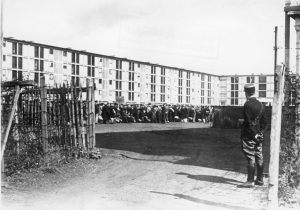August 17, 1944: Liberation of the Drancy Camp

Credits: Shoah Memorial
While the Allies landed in Normandy on June 6, 1944 and the fighting for the liberation of French territory was raging, Aloïs Brunner, the Nazi commander of the Drancy camp continued the "hunt for Jews". About a thousand internees arrive at the Drancy camp in June, another one thousand in July, among whom 250 children were rounded up between July 21 and 25, 1944, in the children’s homes of the UGIF in the Paris region. On July 31, 17 days before the liberation of the Drancy camp, 1,300 internees including 330 children were deported to the Auschwitz camp. In the camp, an atmosphere of terror reigns. Certain signs announce the imminent departure of the Nazis. The latter give the order to destroy the camp archives, but internees manage to save the nominal file of the Drancy camp. Despite Brunner’s efforts to deport the thousand remaining internees, the railway strike decreed by the Resistance paralyzes the rail network. Finally, Brunner obtains the provision of three wagons thanks to which he is able to leave the camp on 17 August 1944, bound for the camp of Buchenwald, also deporting 51 internees, mainly resistance fighters. At least 21 deportees will manage to escape during the transport of this convoy.
After several hours of uncertainty, the internees realize that the Nazis have definitively left the camp and that for them the nightmare has stopped.
The camp of Drancy is then handed over to those who represent the Resistance under the authority of Raoul Nordling, Swedish consul general. The internees leave the camp in a few days.

